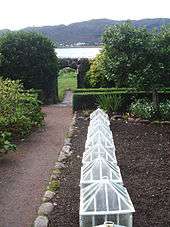Row cover

In agriculture and gardening, row cover is any transparent or semi-transparent, flexible material, like fabric or plastic sheeting, used as a protective covering to shield plants, usually vegetables, primarily from the undesirable effects of cold and wind, and also from insect damage.[1] In addition to reducing the drying effect of wind, row cover can provide a limited amount of warming by the same effect that cold frames, greenhouses, and polytunnels produce, creating a microclimate for the plants.
Material

Commercially available row cover is usually a lightweight synthetic, such as clear plastic (polyethylene) or spunbonded polyester. It is placed directly above rows of crops on a supporting framework—often, on wire hoops to form a low tunnel—and usually left in place for several weeks until crops are well-established.[1]
Floating row cover is extremely lightweight row cover fabric that can be placed directly over plants, without need for a supporting framework, instead being simply anchored to the ground against wind.[1]
Another form of lightweight row cover is made from high-density polyethylene (HDPE) and is a knitted fabric. It is strong, with an claimed life of eight years. It has a low shading effect (16%) and allows natural air flow and rain and water penetration. It also protects from light frosts, strong winds and hail. It is used on low tunnels. It comes in a variety of widths and lengths.
A protective tunnel formed with row cover is sometimes called a cloche,[2] although a cloche, or bell jar, commonly refers to a distinct type of protective covering, made of glass or plastic, usually placed over individual plants. No longer in general use, a type of cloche employed in Europe involved panes of glass attached with wire to form continuous tunnels to protect rows of crops.[3]
See also
References
- 1 2 3 George J. Hochmuth; Robert C. Hochmuth; Steve Kostewicz & William Stall (1987). "Row Covers for Commercial Vegetable Culture in Florida". Institute of Food and Agricultural Sciences (University of Florida). Retrieved 19 March 2015. Article marked reviewed by publisher in 2012.
- ↑ There is some usage of the term cloche to include row cover tunnels, or other season extension covering (as in this somewhat ambiguous Rodale gardening encyclopedia definition)
- ↑ Lee Reich. "All About Cloches". National Gardening Association. Retrieved 19 March 2015.